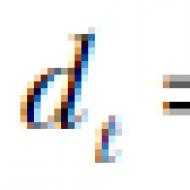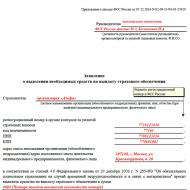
An investment tax credit may be available. Investment tax credit under the burden of restrictions. Legal regulation of the issue
Investment tax credit represents such a change in the tax payment period in which the organization is given the opportunity, within a certain period and within certain limits, to reduce its tax payments with the subsequent stage-by-stage payment of the loan amount and accrued interest.
An investment loan has many of the features of a conventional loan: urgency, payment and repayment. That is why, compared to gratuitous financing of infrastructure projects using funds state budget This measure of support for organizations is more beneficial for the state. Firstly, the funds provided in the form of such a loan will ultimately be returned to the budget, and, secondly, the state will receive income in the form of interest for its use.
An investment tax credit can be granted to an organization if at least one of the following grounds exists:
- 1) carrying out by this organization scientific research or development work or technical re-equipment own production, including those aimed at creating jobs for people with disabilities or protecting environment from pollution by industrial waste;
- 2) implementation by this organization of implementation or innovation activity, including the creation of new or improvement of used technologies, the creation of new types of raw materials or materials;
- 3) fulfillment by this organization of a particularly important order for social economic development region or its provision of particularly important services to the population.
Technical re-equipment can be not only of a production nature, but also aimed at creating jobs for people with disabilities or protecting the environment from pollution by industrial waste. If this condition is met, the amount of the loan provided is 30% of the cost of the purchased equipment used exclusively for the listed purposes. In addition, other grounds may be provided at the regional and local levels.
At the federal level, an investment tax credit can only be provided for an organization’s income tax; appeal of a taxpayer organization in relation to other federal taxes Not provided for by the Tax Code. There are no restrictions on its provision for regional and local taxes in the legislation of the Russian Federation. This loan is provided by the tax service after approval at the federal level with the Ministry of Finance of the Russian Federation, and at the regional and municipal levels - with the relevant committees of regional and local authorities executive power.
In every reporting period(regardless of the number of investment tax credit agreements) the amounts by which tax payments are reduced cannot exceed 50% of the corresponding tax payments determined by general rules excluding the presence of investment tax credit agreements. In this case, the credit amount accumulated during the tax period cannot exceed 50% of the amount of tax payable by the organization for this taxable period. If the accumulated loan amount exceeds maximum dimensions, for which the tax reduction established by this paragraph is allowed for such a reporting period, then the difference between this amount and the maximum allowable amount is carried over to the next reporting period.
An organization that has received an investment tax credit has the right to reduce its payments for the corresponding tax during the validity period of the investment tax credit agreement.
The reduction is made for each payment of the corresponding tax for which an investment tax credit is granted, for each reporting period until the amount not paid by the organization as a result of all such reductions (the accumulated amount of the credit) becomes equal to the amount of the credit provided for by the relevant agreement. Specific order of reduction tax payments determined by the concluded investment tax credit agreement.
Like any other, this type of loan is formalized by an agreement in the established form between the tax authority and the organization applying for it. The form of this agreement is established by the authorized body making the decision to provide this loan. Standard contract approved by Order of the Federal Tax Service of November 29, 2005 No. SAE-Z-19/622.
The agreement on obtaining an investment tax credit must determine the procedure for reducing tax payments by the amount of the loan (indicating the tax for which it was granted); contract time; interest accrued on the loan amount; the procedure for repaying the loan amount and accrued interest; information about the property that is the subject of the pledge, or about the surety; responsibility of the parties. Also, the agreement must contain provisions according to which, during the entire period of its validity, the sale or transfer into possession, use or disposal of equipment or other property to third parties, the acquisition of which by the organization was a condition for the provision of an investment tax credit, is not allowed, or the conditions for such credit must be determined. implementation (transfer).
If an organization has concluded more than one investment tax credit agreement, the validity of which has not expired at the time of the next tax payment, the accumulated amount of the credit is determined separately for each of these agreements. In this case, the increase in the accumulated loan amount is carried out first in relation to the first agreement, and when this accumulated loan amount reaches the size stipulated by the specified agreement, the organization can increase the accumulated loan amount according to next agreement.
If an organization had losses based on the results of individual reporting periods during the tax period or losses based on the results of the entire tax period, the excessively accumulated loan amount based on the results of the tax period is transferred to the next tax period and is recognized as the accumulated loan amount in the first reporting period of the new tax period.
An investment tax credit can be granted for a period of one to five years.
Interest on the loan amount is determined at a rate of no less than one-half and not exceeding three-fourths of the refinancing rate Central Bank Russian Federation.
The investment tax credit is intended to stimulate certain types of activities of taxpayers, because, firstly, the investment tax credit involves the largest change in the deadline for paying the tax, compared to other forms of such a change, this is due to the fact that the effectiveness of investments depends on the deadline , to which they are provided, (although not only from him). Secondly, the investment nature of this credit is confirmed by the fact that the law provides for a large period of time for which an investment tax credit can be granted - from one to five years for the part of the tax that goes to federal budget- after all, a good stimulating effect from an investment can be obtained only by carefully studying the state of affairs in the relevant organization and determining the time for which it is advisable to provide funds, and often in each specific situation this optimal time is completely different, which is why the legislator provided such large spread of minimum and maximum term, for which a loan can be provided (a tax credit for payments to the budget of the Russian Federation is provided for a period of 3 months to a year). Thirdly, the investment nature of the loan is expressed in the fact that the organization is given the right to choose when concluding an agreement when and how much to reduce its tax payments; this rule assumes that when concluding a loan agreement, the organization’s opinion regarding the mode (schedule) of reduction should be taken into account tax payments, since, in fact, most likely, it is the organization that knows best what regime needs to be established for the best investment effect.
Based on certain provisions of the Tax Code of the Russian Federation, an enterprise has the right to reduce taxes. In addition, you can legally formalize a change in the deadlines for paying taxes with the obligation to gradually repay the loan on accrued interest. Such an agreement is drawn up over a certain period of time, and it fixes the established amount of tax reduction. This feature is called the investment tax credit. Below we will describe in more detail what the procedure and conditions for receiving such a benefit are, which every taxpayer will be happy about.
Terms of loan
To obtain this type of loan, at least one of the following conditions must be met:
- The enterprise carries out research, technical, design or socially useful work. For example, it creates working conditions for people with disabilities. This category also includes work related to ecology, for example, protecting nature from the harmful effects of industrial waste.
- Carrying out a set of scientific, technological, organizational, financial and commercial activities, the purpose of which is to create new or improved goods/services.
- The organization participates in improving the socio-economic level of the region or provides goods or services that are particularly significant for the population.
Loan size
Investment loans are issued in the following options:
- 30% of the funds spent on the purchase of equipment. The equipment must be used only for the purposes listed in subparagraph 1 of Art. 66 Tax Code of the Russian Federation.
- The amount of debt, which is determined by agreement of the executive authority and the enterprise involved in the process. Such a debt is issued on the basis of paragraphs. 2 and 3 of the Tax Code of the Russian Federation. After a certain period of time (regardless of the number of loan agreements), the amount of reduction in tax payments should not be more than 50% of the amount of the corresponding tax payments established according to public rules, not taking into account existing investment tax loan agreements.
In addition, the amount of debt should not exceed 50% for the entire period of loan accumulation. If the accumulation debt exceeds the established norm, the difference between the established and the resulting value is transferred to another reporting period. However, this is only possible if the tax reduction is an acceptable measure established by this paragraph for a certain period of time.
The amount of debt should not exceed 50% over the entire period of loan accumulation.
An enterprise that has received an investment tax credit can pay taxes in a smaller amount according to the appropriate tax during the time established by the loan agreement.
You can reduce any payment for which the loan was issued for a period of time until the amount that was accumulated during the loan is equal to what was agreed upon in the agreement. The exact reduction procedure can be determined by the agreement on the issuance of an investment loan.
If a company has entered into several loan agreements, the amount of each debt is calculated separately. We also note that the increase in the amount received is carried out first relative to the initial loan for the period of conclusion, and if the amount of accumulation has reached the limit established in the agreement, then the enterprise has the right to increase the amount under the next agreement.
If the company had excess expenses, which resulted in losses during tax periods or financial losses for the entire period, the loan amount also automatically transfers to the next payment period, and also receives the status of the accumulated amount in the tax period.
Term
An investment loan can be provided for a limited time – from one to five years. The loan period is determined in the negotiation process between the lender and the borrower. Interest on the amount of the debt will be determined at a rate of no less than half and no more than three-quarters of the rate of the new loan for more favorable conditions for complete or partial repayment previous loan.
The loan period is determined in the negotiation process between the lender and the borrower.
To obtain an investment loan, an enterprise must submit an application, after which the process of drawing up an agreement between the executive authority and this enterprise will begin.
Investment agreement
The agreement must include the following points:
- The procedure for reducing tax payments.
- The size of the loan (this point also takes into account the government fee that will be charged on the debt).
- The procedure for paying off debt and interest received.
- Documents for collateral or guarantee (obligation for the fulfillment of obligations).
In order for a company to receive an investment loan, it must provide the following set of documents:
- A formal request for credit made by a taxpayer.
- A document that describes the main aspects entrepreneurial activity, on the basis of which investments can be obtained.
- Information showing the preliminary plan for paying off the debt, as well as the timing of its repayment.
- Determining the tax for which the registration will be made tax debt, confirmed by the tax authority.
- Report on financial condition enterprises.
- Documents for collateral or responsibility for ensuring the taxpayer fulfills his obligations (guarantee).
- Written confirmation of the absence of debts to the city budget (issued by the tax office).
- Documents that serve as the basis for the activities of a legal entity.
For example
A developing region distillery is planning a project to improve and expand production to increase productivity. This means increasing sales of higher quality goods, increasing the number of products produced, and expanding the range. In addition, new equipment will ensure high quality products.
According to experts, the demand for alcoholic products sufficient to increase current sales. An increase in demand from restaurants and bars for alcoholic beverages is expected. Coming soon new year holidays, which increases alcohol sales. In addition, small towns, villages and towns nearby the region are applying for the supply of alcoholic products.
The project is expected to:
- Complete or partial replacement of the enterprise’s existing equipment with newer and more productive equipment.
- Organization of production of a new type of product thanks to a new workshop.
Providing cash resources for current expenses is expected partially from personal Money from the current work of the organization and partially with a loan in the amount of 14,800 thousand rubles. with payment of 24% per annum in rubles. The duration of the agreement determined by the bank is three years from the date of conclusion of the agreement. The bank puts forward its demands in the form of repaying the debt in equal parts of the amount within twelve months in each tax period.
To ensure financial viability (payment full cost loan at a specified time), the organization submits an application for an investment loan for income tax within three years.
Another form of financing the activities of entrepreneurial firms is an investment tax credit. In accordance with Article 66 of the Tax Code of the Russian Federation, an investment tax credit is a change in the tax payment deadline in which129
The organization, if there are appropriate grounds, is given the opportunity, within a certain period and within certain limits, to reduce its tax payments with subsequent stage-by-stage payment of the loan amount and accrued interest. This loan can be provided to a business firm for income tax, as well as for regional and local taxes for a period of 1 to 5 years.
An investment tax credit can be granted to a company that is a taxpayer in the following cases:
- when this company carries out research or development work or technical re-equipment of its own production, including those aimed at creating jobs for people with disabilities or protecting the environment from pollution by industrial waste;
- when this company carries out implementation or innovation activities (including the creation of new or improvement of used technologies, the creation of new types of raw materials or materials);
- if this company carries out a particularly important order for the socio-economic development of the region or provides particularly important services to the population.
An agreement on an investment tax credit must contain the following information: the amount of the loan (indicating the tax for which the loan is provided); duration of the agreement, interest accrued on the loan amount; the procedure for repaying the loan amount and accrued interest; documents on the property that is the subject of the pledge, or a surety; responsibility of the parties.
Besides, this agreement must contain provisions according to which, during the period of its validity, the sale or transfer into possession, use or disposal to other persons of equipment or other property, the acquisition of which by the company was a condition for the provision of an investment tax credit, is not allowed, or the agreement must define the conditions for such sale . A copy of the agreement must be provided by the business firm to the tax authority at the place of its registration within 5 days from the date of conclusion of the agreement.
A company that has received an investment tax credit has the right to reduce its tax payments during the term of the investment tax credit agreement. In this case, the reduction is made for each payment for each reporting period until the amount not paid by the company as a result of all such reductions (the accumulated loan amount) becomes equal to the loan amount specified in the relevant agreement.
If a company has concluded more than one investment tax credit agreement, the validity of which has not expired at the time of the next tax payment, the accumulated amount of the credit is determined separately for each of these agreements. In this case, the increase in the accumulated loan amount is carried out first in relation to the first agreement in terms of the term of conclusion, and when this accumulated loan amount reaches the amount stipulated by the specified agreement, the company can increase the accumulated loan amount under the next agreement.
Regardless of the number of investment tax credit agreements, in each reporting period the amounts by which tax payments are reduced cannot exceed 50% of the corresponding tax payments determined without taking into account the existence of these agreements. In this case, the credit amount accumulated during the tax period cannot exceed 50% of the amount of tax payable by the company for this tax period.
In the case of a business firm conducting R&D, an investment tax credit is provided in an amount equal to 30% of the cost of equipment purchased by the company, used exclusively for carrying out R&D or technical re-equipment. In other cases, an investment tax credit is provided for amounts determined by agreement of the parties when concluding an investment tax credit agreement.
Interest on the loan amount is set at a rate not less than /2 and not exceeding 3/4 of the refinancing rate of the Central Bank of the Russian Federation.
Tax Code of the Russian Federation Article 67. Procedure and conditions for granting investment tax credit
1. An investment tax credit may be granted to an organization that is a taxpayer of the relevant tax if there is at least one of the following grounds:
1) carrying out by this organization research or development work or technical re-equipment of its own production, including those aimed at creating jobs for people with disabilities and (or) increasing the energy efficiency of production of goods, performance of work, provision of services, or implementation of an event or activities to reduce the negative impact on the environment provided for in paragraph 4 of Article 17 of the Federal Law of January 10, 2002 N 7-FZ “On Environmental Protection”;
2) implementation by this organization of implementation or innovation activities, including the creation of new or improvement of used technologies, the creation of new types of raw materials or materials;
3) the fulfillment by this organization of a particularly important order for the socio-economic development of the region or the provision of particularly important services to the population;
4) implementation by the organization of the state defense order;
5) implementation by this organization of investments in the creation of facilities with the highest class of energy efficiency, including apartment buildings, and (or) related to renewable energy sources, and (or) related to objects for the production of thermal energy, electrical energy, having an efficiency factor of more than 57 percent, and (or) other objects, technologies with high energy efficiency, in in accordance with the list approved by the Government of the Russian Federation;
6) inclusion of this organization in the register of residents of the territorial development zone in accordance with the Federal Law
2. Investment tax credit is provided:
1) on the grounds specified in subparagraphs 1 and 5 of paragraph 1 of this article, - for a loan amount amounting to 100 percent of the cost of equipment purchased by the interested organization, used exclusively for the purposes listed in these subparagraphs;
(see text in the previous edition)
2) on the grounds specified in subparagraphs 2 - 4 of paragraph 1 of this article - for the loan amounts determined by agreement between the authorized body and the interested organization;
(see text in the previous edition)
3) on the basis specified in subparagraph 6 of paragraph 1 of this article - for a loan amount that is no more than 100 percent of the amount of expenses for capital investments in the acquisition, creation, retrofitting, reconstruction, modernization, technical re-equipment of depreciable property intended and used for the implementation of investment projects by residents of territorial development zones in accordance with the Federal Law "On Territorial Development Zones in the Russian Federation and on Amendments to Certain legislative acts Russian Federation".
3. The grounds for receiving an investment tax credit must be documented by the interested organization.
4. An investment tax credit is provided on the basis of an application by an organization and is formalized by an agreement in the established form between the relevant authorized body and this organization. IN said statement the organization undertakes the obligation to pay interest accrued on the amount of debt in accordance with this chapter.
(see text in the previous edition)
The form of the investment tax credit agreement is established by the authorized body making the decision to grant an investment tax credit.
(see text in the previous edition)
(see text in the previous edition)
5. The decision to provide an organization with an investment tax credit is made by the authorized body in agreement with financial authorities in accordance with Article 63 of this Code within 30 days from the date of receipt of the application. The presence of one or more investment tax credit agreements with an organization cannot serve as an obstacle to concluding another investment tax credit agreement with this organization on other grounds.
(see text in the previous edition)
In the absence of the circumstances specified in paragraph 1 of Article 62 of this Code, the authorized body does not have the right to refuse an interested person to provide an investment tax credit on the basis specified in subparagraph 6 of paragraph 1 of this article, within the amount of expenses of this person on capital investments in the acquisition, creation , additional equipment, reconstruction, modernization, technical re-equipment of depreciable property intended and used for the implementation by residents of territorial development zones of investment projects in accordance with the Federal Law "On Territorial Development Zones in the Russian Federation and on Amendments to Certain Legislative Acts of the Russian Federation", for a period , specified in the appeal interested person, subject to the restrictions established by Article 66 of this Code.
6. An agreement on an investment tax credit must provide for the procedure for reducing payments for the corresponding tax, the amount of the loan (indicating the tax for which the organization was granted an investment tax credit), the validity period of the agreement, interest accrued on the loan amount, the procedure for repaying the loan amount on time, not exceeding the period for which an investment tax credit is provided in accordance with the agreement, the procedure and period for repayment of accrued interest, an indication of the method of securing obligations, and the responsibilities of the parties. If an investment tax credit is provided on the security of property, an agreement on the pledge of property is concluded in the manner prescribed
In accordance with Art. 68 of the Tax Code of the Russian Federation, the effect of innovative tax crediting (ITC) is terminated upon expiration of the relevant decision or agreement, by agreement of the parties or by court decision.
This credit is terminated early if the taxpayer pays the entire amount of tax and fee due, as well as the corresponding interest, before the expiration of the established period.
If during the term of the INC agreement the organization that concluded it violates provided for by the agreement conditions for the sale or transfer into possession, use or disposal of equipment or other property to other persons, the acquisition of which was the basis for the provision of the INC, this organization, within 30 days from the date of termination of the agreement on the INC, is obliged to pay all amounts of tax previously unpaid in accordance with the agreement, as well as corresponding penalties and interest on unpaid tax amounts accrued for each day of validity of the INC agreement, based on the refinancing rate of the Central Bank of the Russian Federation in effect for the period from conclusion to termination the said agreement.
Let us remind you that in accordance with paragraph 1 of Art. 67 of the Tax Code of the Russian Federation INC can be provided to an organization that is a taxpayer of the corresponding tax.
INK, on the basis of Art. 66 of the Tax Code of the Russian Federation, represents such a change in the tax payment period in which an organization, if there are grounds, is given the opportunity, within a certain period and within certain limits, to reduce its tax payments with subsequent stage-by-stage payment of the loan amount and accrued interest.
On such grounds, according to Art. 67 of the Tax Code of the Russian Federation are:
- carrying out by this organization research or development work or technical re-equipment of its own production, including those aimed at creating jobs for people with disabilities or protecting the environment from pollution by industrial waste;
- implementation by this organization of implementation or innovation activities, including the creation of new or improvement of used technologies, the creation of new types of raw materials or materials;
- the fulfillment by this organization of a particularly important order for the socio-economic development of the region or the provision of particularly important services to the population.
This loan can be provided both for corporate income tax and for regional and local taxes, for a period of one to five years. The organization that received this loan, has the right to reduce its payments for the relevant tax during the term of the investment tax credit agreement.
In the article by O.V. Antipina it is written that a reduction in tax payments for which the INC is provided for each reporting period until the amount not paid by the organization as a result of all such reductions (the accumulated loan amount) becomes equal to the loan amount provided for in the relevant agreement. It must be remembered that the specific procedure for reducing tax payments is determined by the concluded INC agreement.
In each reporting period, the amounts by which tax payments are reduced cannot exceed 50% of the amounts of the corresponding tax payments, determined according to the general rules without taking into account the presence of agreements on INC. In this case, the credit amount accumulated during the tax period cannot exceed 50% of the amount of tax payable by the organization for this tax period.
INC is provided on the basis of an application by an organization and is formalized in an agreement of the established form between the relevant authorized body and this organization, which provides for the procedure for reducing tax payments; loan amount (indicating the tax for which the organization was provided with an INC); contract time; interest accrued on the loan amount; the procedure for repaying the loan amount and accrued interest; documents about the property that is the subject of the pledge.
The absence of tax debts and criminal cases does not bring you any closer to the “cherished loan”, because the only factor that visibly confirms your differences from other respectable borrowers is a business plan. From the thoroughness, depth and realism of compilation of this document Not only the possibility of obtaining a loan depends, but also the future of your company for the entire loan term. All future financial and economic activities of the borrower are subsequently compared and assessed (including tax authorities) based on the parameters specified and approved in the business plan.
Therefore, you should entrust the preparation of a business plan to experienced specialists. It should be especially taken into account that almost all administrations (regional and local) have a list of accredited consulting companies specifically authorized to develop business plans. Such companies take into account all the “specific local requirements” for the document and for a “certain fee”, often legal, will help you agree on the main parameters of the business plan with the relevant committee, which practically guarantees the receipt of an investment loan.
The established practice of accredited consulting companies does not at all exclude “ market competition" However, business plans prepared by non-accredited companies, naturally for a fee, are subject to mandatory “examination” by accredited consultants. Similar requirements are established by internal regulations of regional and local administrations, interested in having “specially authorized and professional” specialists in business planning.
Along with the requirements for the procedure for developing a business plan, the requirements for its content should also be taken into account.
Nechaev A.S. in his article refers to the content, requirements and form of the business plan established by Decree of the Government of the Russian Federation of November 22, 1997 No. 1470 “On approval of the Procedure for providing state guarantees on a competitive basis at the expense of the Development Budget of the Russian Federation and the Regulations on assessing the effectiveness of investment projects when placed on a competitive basis based on centralized investment resources Development budget of the Russian Federation".
In accordance with the specified resolution of the Government of the Russian Federation, the structure of the business plan is as follows:
- Introductory part (project summary) describing general characteristics, name, purpose and evidence of its profitability;
- Analysis of the state of affairs in the industry, general characteristics of the need for manufactured products and the volume of their production in the region (country, world - depending on the planned area for promoting the product). The significance of this production for the economic and social development region;
- Production plan with a program for production and sales of products;
- A marketing plan that takes into account: sales organization and quality characteristics of the sales network; justification of the volume of investments associated with the sale of products; calculation of trade and sales costs;
- The organizational plan consists of general information about the applicant, its legal status, amount of authorized capital;
- Financial plan, which is a key section where cost items for the project are detailed and determined economic efficiency project.
Along with the mandatory requirements established by federal legislation, constituent entities of the Russian Federation and municipalities have the right to impose additional requirements for a business plan that provides for receiving an investment tax credit. As a rule, such requirements are issued in the form of a method of recommendations (for example, a Government resolution Leningrad region dated March 30, 1998 No. 11 “On approval of the methodology for calculating the payback period and the period of actual payback of investments for the implementation of preferential tax treatment”).
Obtaining an investment tax credit
The procedure and conditions for submission, as well as the grounds and procedure for termination of the INC are regulated by Articles 66, 67, 68 of the Tax Code of the Russian Federation, as well as other regulatory documents. The main “investment” points are shown in table. 1.
Table 1. Procedure and conditions for providing INC
| Criterion | Conditions | Regulatory Standard |
|---|---|---|
| Purpose of the loan | Stimulating innovation and research activities in the Russian Federation | |
| Recipient | Any legal entity | clause 1 art. 66 Tax Code of the Russian Federation |
| For what taxes is it issued? | - on income tax; - for regional and local taxes |
|
| Credit term | From 1 to 5 years | |
| Grounds for issuing a loan (at least one ground is sufficient) | 1) carrying out research and development work by the company; 2) implementation of implementation or innovation activities; 3) promoting the development of the region or providing the population with particularly important services |
|
| Benefits of a loan | Possibility to reduce payments for the relevant tax during the term of the investment tax credit agreement | clause 2 art. 66 Tax Code of the Russian Federation |
| Procedure for reducing payments | The reduction is made for each payment of the corresponding tax for which the investment tax credit is granted, for each reporting period until the amount not paid by the company as a result of the reductions (accumulated credit amount) becomes equal to the loan amount under the agreement. | clause 2 art. 66 Tax Code of the Russian Federation |
| Restrictions | 1. In each reporting period, the amounts by which tax payments are reduced cannot exceed 50 percent of the amounts of the corresponding tax payments, determined according to the general rules without taking into account the existence of investment tax credit agreements. 2. The credit amount accumulated during the tax period cannot exceed 50 percent of the amount of tax that is payable by the company for this tax period |
clause 3 art. 66 Tax Code of the Russian Federation |
| Interest | They are determined by agreement of the parties, but the amount of interest cannot be lower than 1/2 and higher than 3/4 of the refinancing rate of the Bank of Russia. | clause 6 art. 67 Tax Code of the Russian Federation |
| “Punishment” for violating the terms of the contract | The company is obliged to pay penalties and interest on unpaid tax amounts accrued for each calendar day of the agreement (based on the refinancing rate of the Bank of Russia, which was in effect for the period from conclusion to termination of the specified agreement). | clause 8 art. 68 Tax Code of the Russian Federation |
Reasons for obtaining a loan
Articles 66 and 67 of the Tax Code of the Russian Federation are devoted to the issues of obtaining and using INC. It states that only an organization can obtain an INC for a period of 1 to 5 years. The loan can be provided for corporate profit (income) tax, as well as for regional and local taxes. The grounds for obtaining a loan may be as follows:
- carrying out by the organization research or development work (R&D) or technical re-equipment of its own production, including those aimed at creating jobs for people with disabilities or protecting the environment from pollution by industrial waste;
- implementation by the organization of implementation or innovation activities, including the creation of new or improvement of used technologies, the creation of new types of raw materials or materials;
- execution by an organization of a particularly important order for the socio-economic development of the region or its provision of particularly important services to the population.
Interest calculation.
The agreement for the provision of INK must provide for the procedure for returning the loan and interest for its use, and:
- a period is established during which the loan and interest on it will be repaid;
- it is determined whether these payments will be monthly or quarterly;
- a schedule for the return of funds is approved (before signing an agreement for the provision of an INC, it is agreed upon with the Ministry of Finance of the Russian Federation, and, if necessary, can be clarified after the loan amount has been fully accumulated).
Interest on the provided INC is accrued until the loan amount is fully repaid and is repaid simultaneously with the repayment of the loan. In accordance with Art. 67 of the Tax Code of the Russian Federation, it is not allowed to set interest on the loan amount at a rate less than one-half and exceeding three-fourths of the refinancing rate of the Central Bank of the Russian Federation. Based on the instruction of the Bank of Russia dated December 25, 2009 No. 2369-U “On the amount of the refinancing rate of the Bank of Russia” 8.75% per annum.
At the same time, the Letter of the Ministry of Taxes of the Russian Federation “On the procedure for calculating interest for the use of budget funds” can be taken as the basis for calculating interest for the use of budget funds when providing deferments, installments for the payment of taxes and other obligatory payments.
The interest rate for INC is set depending on numerous factors, which are based on:
- sources of repayment of this loan;
- pledge;
- liquidity of property or other funds of the taxpayer;
- business plan;
- profitability;
- the need to produce this type of product; the founders of this organization and their share of ownership.
The interest rate on the amount of INC for regional taxes is set from one ten-thousandth to three-quarters of the refinancing rate of the Central Bank of the Russian Federation.
The main differences between INKot and other forms of changing the deadline for paying tax payments.
- INC, unlike a tax credit, is targeted in nature and is provided to encourage the investment activity of the loan recipient. Therefore, obtaining an INC is associated with the need to make certain expenses (for example, R&D).
- In contrast to deferment or installment payment of taxes, the amount of interest on the loan does not depend on the basis for providing INC.
- INC is provided for the profit (income) tax of the organization and for regional and local taxes. For other forms of changing the deadline for payment of tax payments, specific types of taxes are not defined in the Tax Code of the Russian Federation.
- The significant difference is the subject of the loan. INK is provided exclusively to organizations.
- Availability of special rules for the accumulation and repayment of tax debts and interest.
- Unlike the tax credit agreement, the INC agreement specifies special conditions that limit the right of the interested party to dispose of equipment or other property, the acquisition of which was a condition for the provision of the INC.
To initially understand the essence of tax crediting, it is necessary to define the terminology. The Tax Code of the Russian Federation distinguishes two independent forms of deferment or installment payment of tax payments: tax credit and INC. A tax credit is a change in the deadline for paying a tax, if there are grounds provided for in Article 64 of the Tax Code of the Russian Federation, for a period of one to six months, with a one-time or phased payment by the taxpayer of the amount owed.
So, according to the Tax Code of the Russian Federation, a tax credit is a type of deferment or installment plan (depending on the procedure for execution tax liability provided for in the agreement), despite a number of differences (the period for which tax payment is postponed, the procedure for granting a loan - not only the decision of the authorized body, but also the agreement on the provision of the loan, the grounds for its provision, the interest rate), which allows us to talk about several hasty use of the concept of tax credit in in this case. This is supported, in particular, by studies of the tax credit category by legal scholars and economists.
For ease of perception of the data, we will make a comparison in the form of a table. 2.
Table 2. Comparison of tax credit and INC
| Criterion | Tax credit | Investment loan |
|---|---|---|
| Conditions (cases) of provision | 1) damage to the borrower as a result of a natural disaster, man-made disaster or other force majeure circumstances; 2) delays to the borrower in financing from the budget or payment for a government order completed by this person; 3) threats of bankruptcy of the borrower in the event lump sum payment them tax. |
1) the borrower carries out research or development work, or technical re-equipment of its own production; 2) implementation by the borrower of implementation or innovation activities, including the creation of new or improvement of used technologies, the creation of new types of raw materials and materials; 3) the borrower fulfills a particularly important order for the socio-economic development of the region or provides them with particularly important services to the population |
| Loan terms | from 3 months to 1 year | from 1 year to 5 years |
| Loan size | no more than the amount of damage or delay in financing | from 30% to 100% of the cost of work (property) |
| Loan interest rate | from 0% to 6.5% per annum | from 6.5% to 13% per annum |
| Types of taxes for which crediting is carried out | federal, regional, local taxes | income tax (in the part credited to the regional and local budgets), as well as regional and local taxes |
| Opportunity early return credit (offset) | yes, without interest it is possible to offset the overpayment (for example, for export VAT) | yes, no interest |
| Creditor status | Federal, regional and local tax services | federal, regional and local tax services, with the participation of specialized committees of regional executive authorities of constituent entities of the Russian Federation and/or municipalities |
| Borrower status | taxpayer | taxpayer |
| Surety | mostly, yes | mostly, no |
| General requirements for borrowers | absence: - initiated criminal case on taxes and fees; - administrative proceedings on taxes and fees; - reasons to believe that the loan is obtained for the purpose of tax evasion; - no debt on regional and local taxes; - availability of grounds for the right to receive a loan |
|
INC differs from a bank loan, and even more so from a deferment (installment plan) for the payment of tax payments - they have different reasons for receiving and goals pursued by the lender.
The purpose of a bank loan is to make a profit by the bank. In this case, the grounds for obtaining a loan can be any; it is enough for the bank to be sure that the borrower is able to provide appropriate provision and pay the accrued interest.
The purpose of providing a deferment (installment plan) for the payment of taxes and fees is to prevent bankruptcy of the taxpayer. At the same time, the number of grounds for obtaining a deferment (installment plan) is limited.
INC pursues the goal of supporting the innovative development of the economy or the implementation by organizations of a number of important socio-economic tasks that do not have high financial profitability. At the same time, changing the deadline for paying tax allows an organization, if there are appropriate grounds, to reduce tax payments within a certain period and within certain limits, followed by stage-by-stage payment of the reduction amounts and interest accrued on them.
Other differences: the number of grounds for providing an INC is limited compared to a bank loan, and the borrower is not financially insolvent, as is the case with the provision of a deferment (installment plan) (Table 3). Prokopyeva A.V. writes that, in addition, government bodies when providing INC, they do not aim to obtain financial benefits, since interest rate By this species The loan cannot exceed the refinancing rate of the Bank of Russia.
Table 3. Comparative characteristics different ways lending
| Characteristics | INK | Bank loan | Deferment (installment plan) for payment of taxes and fees |
|---|---|---|---|
| Grounds for grants | Established by the state | Depends only on economic policy jar | Established by the state |
| Security | Bail, surety | Pledge, surety, guarantee | In some cases - not necessarily |
| Mandatory provision for the creditor | Not required | Not required | In some cases it is mandatory |
| Purpose of the creditor's actions | Innovative development economy | Receiving a profit | Preventing taxpayer bankruptcy |
| Interest rate | Established by the state | Depends on the conditions of the prisoner loan agreement | Established by the state (in some cases not charged) |
| Nature of funds provided | Taxpayer funds | Own funds jar | No funds provided |
| Decision-making bodies | State | Bank management | State |
Contrary to popular belief, INC is not a type of budget loan.
Firstly, the norms of the Tax Code of the Russian Federation cannot be applied to tax legal relations due to the provisions of Art. 1 BC RF and Art. 2 Tax Code of the Russian Federation. Budget legislation regulates relations regarding the distribution and use of funds, while tax law- the order of their accumulation.
Secondly, the INC does not comply with what is established in Art. 6 of the Budget Code of the Russian Federation, defining the concept of “budget loan” - forms of financing budget expenditures, which provides for the provision of funds to legal entities or other budgets on a repayable and reimbursable basis. That is, without providing the borrower with funds directly from the budget, a loan of the type in question will not be formed.
Meanwhile, funds are considered budgetary (credited to the income of the corresponding budget) only from the moment the Bank of Russia commits or credit institution operations for crediting (accounting) funds to the account of the body executing the budget, which follows from Art. 40 BC RF.
Bibliography
1. Antipina O. V. Innovative and investment development of territories in the municipal management system. - Dissertation for the candidate’s scientific degree economic sciences. Irkutsk State Technical University. Irkutsk, 2011.
2. Antipina O.V. Innovative and investment development of territories in the system of municipal government. - Abstract of the dissertation for the degree of Candidate of Economic Sciences. Irkutsk State Technical University. Irkutsk, 2011.
3. Antipina O.V., Belyakova L.G. Application of correlation and regression analysis to study indicators of innovation and investment development of municipalities. - Bulletin of ISTU. - Irkutsk, 2011.- No. 12 (59). - pp. 252-255.
4. Antipina O. V. Innovative and investment development of municipalities of the Irkutsk region: problems and solutions. - Economics and Management. - St. Petersburg, 2011. - No. 12 (74) - P. 32-36.
5. Dubynin A.R., Ognev D.V., Nechaev A.S. Methodological aspects of attracting investment in Russian industry. - Bulletin of the Angarsk State Technical Academy. 2007. T. 1. No. 1. P. 70-74.
6. tax code Russian Federation. Parts one and two: with changes. and additional as of January 1, 2012 - M.: Eskimo, 2012. - 954 p.
7. Nechaev A.S. Control investment project as the basis for updating fixed production assets. - Entrepreneur's Guide. 2009. No. III. pp. 219-230.
8. Nechaev A.S. Factors of labor productivity growth at Russian enterprises. - Labor and social relations. 2009. No. 9. P. 52-58.
9. Nechaev A.S., Starkov R.F. Some aspects of investing in the organization of production processes in modern economic conditions. - Bulletin of Irkutsk State Technical University. 2013. - No. 11 (82). pp. 365-371.
10. Nechaev A.S. Investment project management as the basis for updating fixed production assets. - Entrepreneur's Guide. 2009. No. 3. pp. 219-230.
11. Ovanesyan S.S., Budaeva M.S. Application of correction factors for calculating the terms of credit and leasing. - Bulletin of Novosibirsk state university. Series: Socio-economic sciences. 2008. T. 8. No. 3. P. 61-67.
12. Ognev D.V., Nechaev A.S., Dubynin A.R. Strategy for attracting investment in Russian industry. - Bulletin of the Siberian State Aerospace University named after. Academician M.F. Reshetneva. 2006. No. 5. P. 184-187.
13. Parkhacheva M.A. Transport tax. Features of payment by legal and individuals: tutorial/ M.A. Parkhacheva, E.L. Sharonova - St. Petersburg: iter, 2009. - 154 p. 4. Law of the Tyumen region of November 19, 2002. No. 93 (as of February 25, 2009). Official website of the Federal Tax Service of Russia
14. Prokopyeva A. V. Justification of a unified classification of innovation risks. - Bulletin of Irkutsk State Technical University. 2012. T. 64. No. 5. P. 236-239.
15. Prokopyeva A. V. The existence of innovation risk in the activities of an economic entity. - Modern research on social problems (electronic scientific journal). 2012. No. 3. P. 12.
16. Prokopyeva A.V. Analysis of the effectiveness of innovation activities. - Current issues economic sciences. 2012. No. 25-1. pp. 160-164.
















